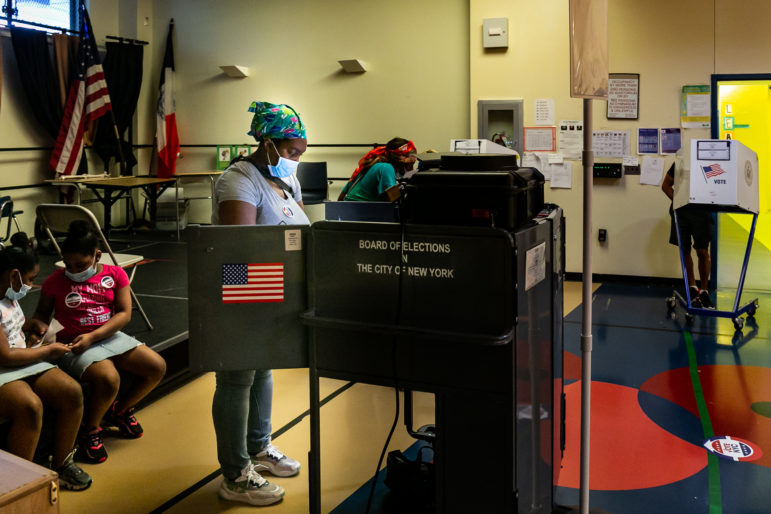Election 2020 not over: Its final chapter opens Monday at 10 a.m., when the New York City Board of Elections begins the canvas of absentee and affidavit ballots—at least 668,000 of which have been received.

Adi Talwar
A voter participates in the June 2020 primary.The television networks have called the race, president-elect Joe Biden has delivered his victory speech and a few in President Donald Trump’s inner circle might have tried to break the bad news to the commander-in-chief. Election 2020, however, is not over. Its final chapter opens Monday at 10 a.m., when the New York City Board of Elections begins the canvas of absentee and affidavit ballots—at least 668,000 of which have been received.
The tallying will run seven days a week until it is done, and will take place in BOE facilities at 1780 Grand Concourse in the Bronx, 450 West 33rd Street in Manhattan, 51-12 2nd Avenue in Brooklyn and 1 Edgewater Plaza in Staten Island, as well as at CitiField in Queens. This last stage of the count will determine the winner of a Congressional race, a State Senate contest and two State Assembly elections, as well as help decide the winner of another Congressional seat.
The board can accept domestic ballots postmarked by Election Day until Tuesday, Nov. 10, and overseas ballots until Nov. 16. All those ballots matter, even in the races in which there is no suspense, because they represent people’s votes. But here’s a breakdown of the races where the outstanding votes could make a real difference:
11th Congressional District: Republican Assemblywoman Nicole Malliotakis claimed victory on election night with a 37,000-vote lead, but incumbent Democratic Rep. Max Rose did not concede, citing the large number of absentee ballots that were outstanding. At the BOE’s last count, released Friday evening, a little over 48,000 ballots had come in for district 11. It’s unclear if any of the nearly 30,000 other absentee ballots that were requested but had not been received by Friday will arrive in time to count. Rose would need 88 percent of the current absentee ballots to break his way in order to win. That is a very, very tall order considering that only 57 percent of the ballots received are from registered Democrats. The one glimmer of hope for Rose is that he did achieve some degree of cross-over in the Election Day results, receiving a few thousand more votes than Biden in the district, while Malliotakis notched a few thousand fewer than Trump received. If a lot of the Republican mail-in ballots do the same, Rose might squeak by.
22nd State Senate District: Like the Rose seat, this area in southern Brooklyn is another district that swung red to blue in 2018 and could now swing back. Incumbent Democratic Sen. Andrew Gounardes trails Republican nightclub owner Vito Bruno by 6,000 votes with more than 18,000 absentee ballots to count. Gounardes would need 66 percent of those ballots to break his way. Just under 63 percent of the ballots received so far are from registered Democrats.
26th Assembly District: Five-term Democratic incumbent Edward Braunstein trails Republican John-Alexander M. Sakelos by just under 1,800 votes with 15,000 absentee ballots out there, 63 percent of them from registered Democrats. Braunstein needs 55 percent of the remaining ballots in order to hang on to his seat representing Little Neck, Bay Terrace and parts of Whitestone.
46th Assembly District: Mathylde Frontus, a Democrat, is in her first term representing parts of Bay Ridge, Dyker Heights and Coney Island, and she trails Republican Mark Szuszkiewicz by 2,800 votes. Only 7,000 absentee ballots are reported in. Frontus would need 70 percent of them, and only 64 percent are from registered Democrats.
3rd Congressional District: Incumbent Democrat Thomas Suozzi trails Republican George Santos by roughly 4,200 votes. Much of the district lies in Nassau County, which is counting separately, but some 15,000 absentee ballots were filed on the Queens side—9,900 of which came from registered Democrats.









